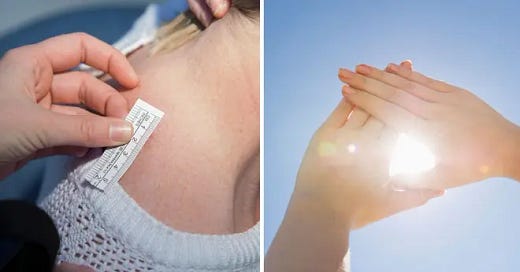The hot topic for today - the UK is under a tsunami wave of melanoma cancers, e.g. “Melanoma skin cancer cases at all-time high as cancer charity warns people to protect themselves from sun” (LBC, 2024.05.27):
Cancer Research UK has predicted a record 20,800 diagnoses this year - an increase of almost a third in the last decade and a rise on the yearly average of 19,300 between 2020 and 2022.
Cancer Research has advised people to spend time in the shade between 11am and 3pm, to wear protective clothing and to frequently apply sunscreen with an SPF of at least 30 and 4 or 5 stars.
As luck would have it, a recent interview with Dr. Paul Marik (2024.05.07), the FLCCC hero, touched exactly on this topic:
“Sunlight is bad for you as it increases your risk of cancer and sunscreen is healthy for you as it decreases your cancer risk.” Wrong. It is quite the opposite.
Marik quotes a Swedish Study that shows sunscreen users have almost double the risk of skin cancer. “It should be noted that sunscreen users in Sweden have been reported to be at an 80% increased risk of melanoma. (OR=1.8, 95%CI=1.1-2.9). (413) A plausible explanation of this increased melanoma risk might be that the application of a sunscreen inhibits the redness of the skin but allows prolonged UV exposure.”
Or God-forbid, perhaps those chemicals contained in the sunscreen were toxic and increased cancer risk. We know at least two sunscreen chemicals were recently banned due to safety concerns and potential carcinogenicity - para-aminobenzoic acid (PABA) and trolamine salicylate. That would have been nice to know these past 30 years.
There are skin cancers related to sun exposure, like squamous cell and basal cell carcinomas. They occur disproportionately in the most sun-exposed skin areas. While the face contains roughly 6.5% of the body’s surface area, more than 87% of squamous cell carcinomas form there. By contrast, only 22% of melanomas grow on the face. The vast majority occur in areas where the sun does not shine. What is truly astonishing - to put this in Dr. Marik’s parlance - is that a study by Merrill and colleagues showed melanoma risk has risen exponentially since 1960 despite decreasing UV sunlight exposure - and all of that sunscreen.
An Italian study revealed that sun holidays following melanoma diagnosis were associated with an improved prognosis. Dr. Marik explains that “you can’t have it both ways.” Either sunlight promotes melanoma, or it reduces it. And the Italian study authors, trying hard to find confounding variables could not. Not sunbeds. Not other indicators of UV exposure. The strongest association was sun exposure holidays, which was inversely related to melanoma - in thickness, ulceration, and recurrence - in a dose-dependent manner. The more sun, the better the prognosis.
In study after study, low Vitamin D3 levels were the underlying cancer-causing culprit. Sun exposure, it turns out, is healthy and cancer-reducing almost always. So, it should come as no surprise that Dr. Marik’s Number One repurposed anti-cancer drug based on the most evidenced-based support is Vitamin D3. It also should be no shock that sunlight is advised as an anti-cancer tool for those who suffer from the disease. Surprisingly it is NOT because UV sunlight leads to the production of Vitamin D3 although that plays a role. The most important reason is different. It is because near-infrared sunlight which occupies more of the sunlight’s spectrum than UV is mitochondria friendly. Near-infrared sunlight has numerous beneficial effects on mitochondrial function, especially those functions involved in ATP production in the electron transport system.
Maybe there is another ulterior motive to this new wave of melanoma-promoting hysteria? “Coming Soon: The First mRNA Vaccine for Melanoma?” (MedScape, 2024.01.17):
Moderna and Merck have presented promising results from their phase 2b clinical trial that investigated a combination of a messenger RNA (mRNA) vaccine and a cancer drug for the treatment of melanoma.
Of course!
Courtesy of more-then-the-reader FastEddy:





anything the government "health experts" advise, you can't go wrong if you do the reverse
Our bodies need the sun and the D3 that comes from it. Everything needs the sun. Including us and when you sunscreen you're blocking getting what your body needs from the sun. That stuff is black on your skin under black lights i read.